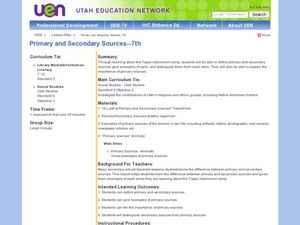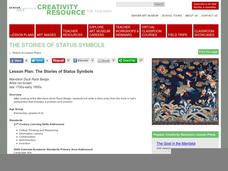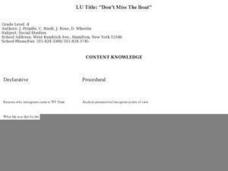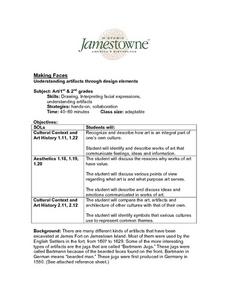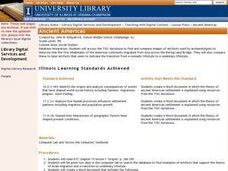Curated OER
Primary and Secondary Sources - 7th
A link to a beautiful Animoto presentation is included, giving examples of primary sources that a student might want to contact when doing research. Using the Topaz Internment Camp in Utah as a sample topic, middle schoolers view a slide...
Curated OER
The Stories of Status Symbols
A good writer needs to be observant and have an imagination. Hone those creative writing skills with an activity inspired by a very old Chinese artifact. Learners examine the piece Mandarin Duck Rank Badge, and then write a story from...
Curated OER
Celebrating Ancestors
Learners participate in a "hands-on" activity, to explain that African masks were and are more than aesthetic artifacts, they are functional implements of the many cultures of the African continent.
Curated OER
Poverty Point Earthworks: Louisiana's Ancient Inhabitants
Students research the prehistoric earthworks site at Poverty Point, Louisiana. They compare the Louisiana artifacts and structure to the remains and knowledge of other ancient cultures. They present their research to the class.
Curated OER
Analyzing Civil War Pictorial Envelopes
Students explore the power of political messages contained in visual artifacts and examine the political messages conveyed by the illustrations that appeared on personal stationery used during the Civil War. They create and describe a...
Curated OER
Westmoreland Trail
Seventh graders complete a unit of lessons on the Westward expansion of the U.S. They play the computer game, Oregon Trail III, read primary source documents, conduct Internet research, write diary entries from the pioneer viewpoint, and...
Curated OER
Shadows of North Carolina's Past
Students construct a timeline of four major culture periods in Native American history from studying archaeological evidence cards.
Curated OER
Aboriginal Peoples And The Universals of Culture
Sixth graders research specific features of a province or territory of Canada. In this Canadian history lesson, 6th graders identify aboriginal culture areas on a map, identify cultural features represented in their region, and create...
Curated OER
Texas Treasures
Students explore the meanings of the word "treasure," and examine the use of clay in the construction of buildings in San Antonio, Texas. They examine clay artifacts, and watch a video about pottery artist, Harding Black. Students then...
Curated OER
Don't Miss The Boat
Fourth graders study immigration and what it is like to be an immigrant. They choose immigrant identities, dress appropriately, and role play during an International Fair where each student displays some aspect of his/her "home country."
Curated OER
Dying to be a Martyr
Young scholars study primary source document that describe the beginnings of the Middle East conflict. They survey the connections that Judaism, Christianity, and Islam have to Israel.
Curated OER
Revolutionary Women of South Carolina
Students examine multiple primary sources. In this revolutionary war lesson, students read case studies regarding women from South Carolina. Students will compare the different roles women played during the Revolutionary War. Students...
Curated OER
Southeastern Native Americans' Lifestyles
Young scholars complete activities to learn about Southeastern Native Americans. In this lifestyles lesson, students watch a PowerPoint about Southeastern Native Americans, view artifacts from the region and discuss the objects with a...
Curated OER
American Colonial Life in the Late 1700s: Distant Cousins
Young scholars research how early colonists lived. They investigate late 17th century colonist's lives from Massachusetts and Delaware. Using their research, students write historical fiction in the form of friendly letters between the...
Curated OER
Splendide Californie French Artists’ Impressionsof the Golden State, 1786-1900
There is a lot to learn from art. This teacher's guide provides you with extensive background information, activities, and a scripted commentary to accompany a slide show on French artists in California during the Gold Rush Period. The...
Curated OER
Jazz in America
Young scholars participate in a class discussion about jazz music, compare improvisation with regular conversion, listen to various jazz musicians and compare and contrast their individual sounds.
Smithsonian Institution
Changing Gender Roles on the Home Front
Many historians discuss how gender roles changed because of World War II, but how did this come to be? An informative resource challenges scholars to do some digging and research the information for themselves. They research how...
Curated OER
Artifacts We Don't Dig Up
Students play a game of artifact show and tell using household items.
Curated OER
Making Faces: Understanding Artifacts Through Design Elements
Students examine and discuss drinking container artifacts from Jamestown. They view images of the artifacts, discuss their purposes, draw an original facial expression for a brown paper jug, and write a description of the facial expression.
Curated OER
Ancient Americas
Seventh graders compare artifacts used by archaeologists to theorize the first inhabitants of the Americas migrated from Asia across the Bering Land Bridge.
Curated OER
Jean Hasbrouck House
Students research lifestyles from the 18th century. They examine artifacts from the Jean Hasbrouck House and associate them with the responsibilities and roles of the people who lived there. They make candles and consider the importance...
Curated OER
Archeology of the Future
Students are introduced to the basic vocabulary of archeology. Using the vocabulary, they classify artifacts and make inferences about their uses. In groups, they create a chart for the criteria needed to analyze artifacts and share...
Curated OER
Location, Location, Location: Using a Grid to Determine Context
Seventh graders are introduced to making inferences about artifacts. Using a grid system, they locate the artifacts and determine where they originated from. They use this information to make conclusions about the way people lived...
Curated OER
Second Grade Time Capsules
Second graders leave clues from the past for students of the future by creating time capsules filled with artifacts from the year. These artifacts are buried along with others on school grounds somewhere. Students identify and analyze...


